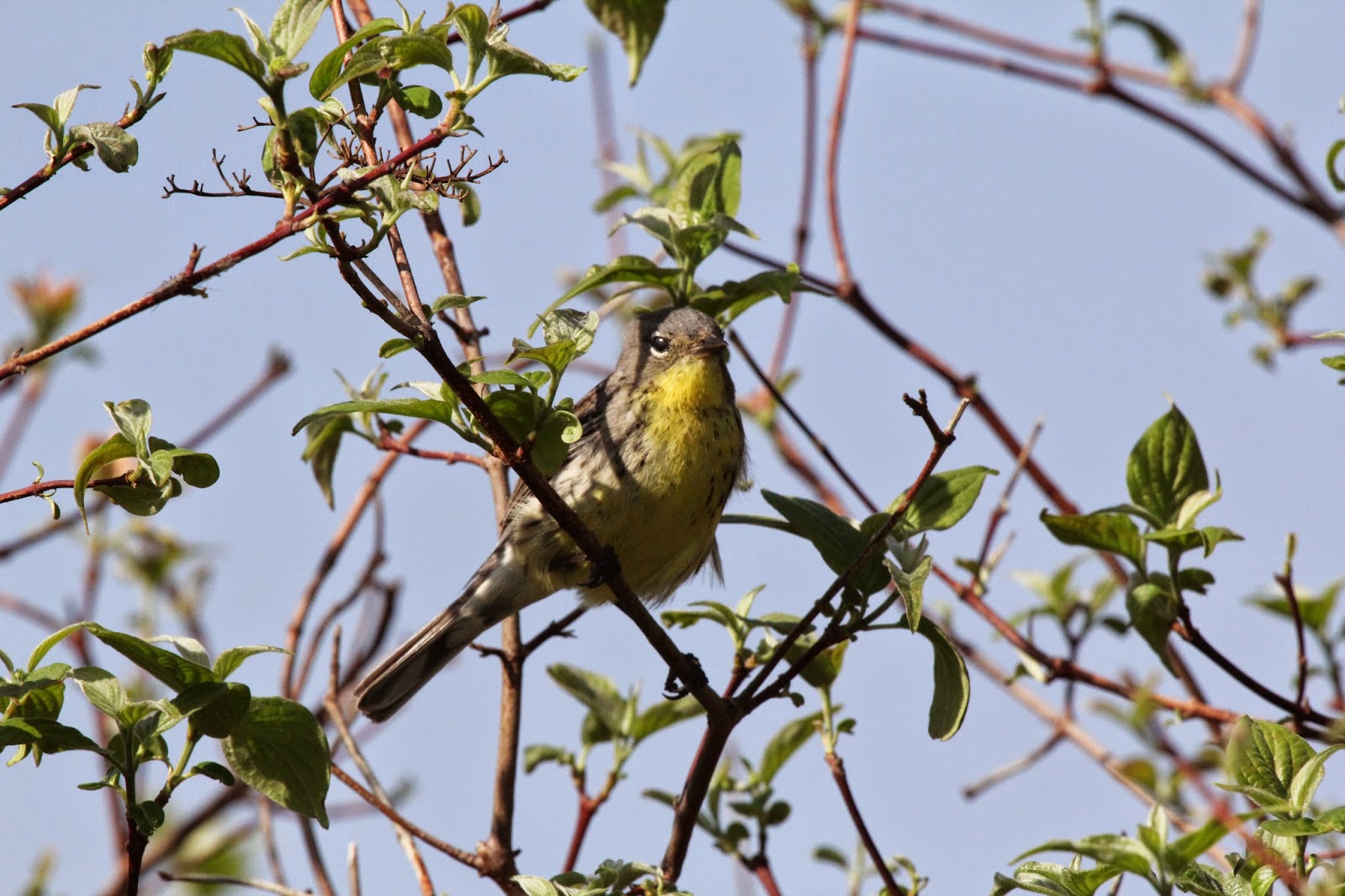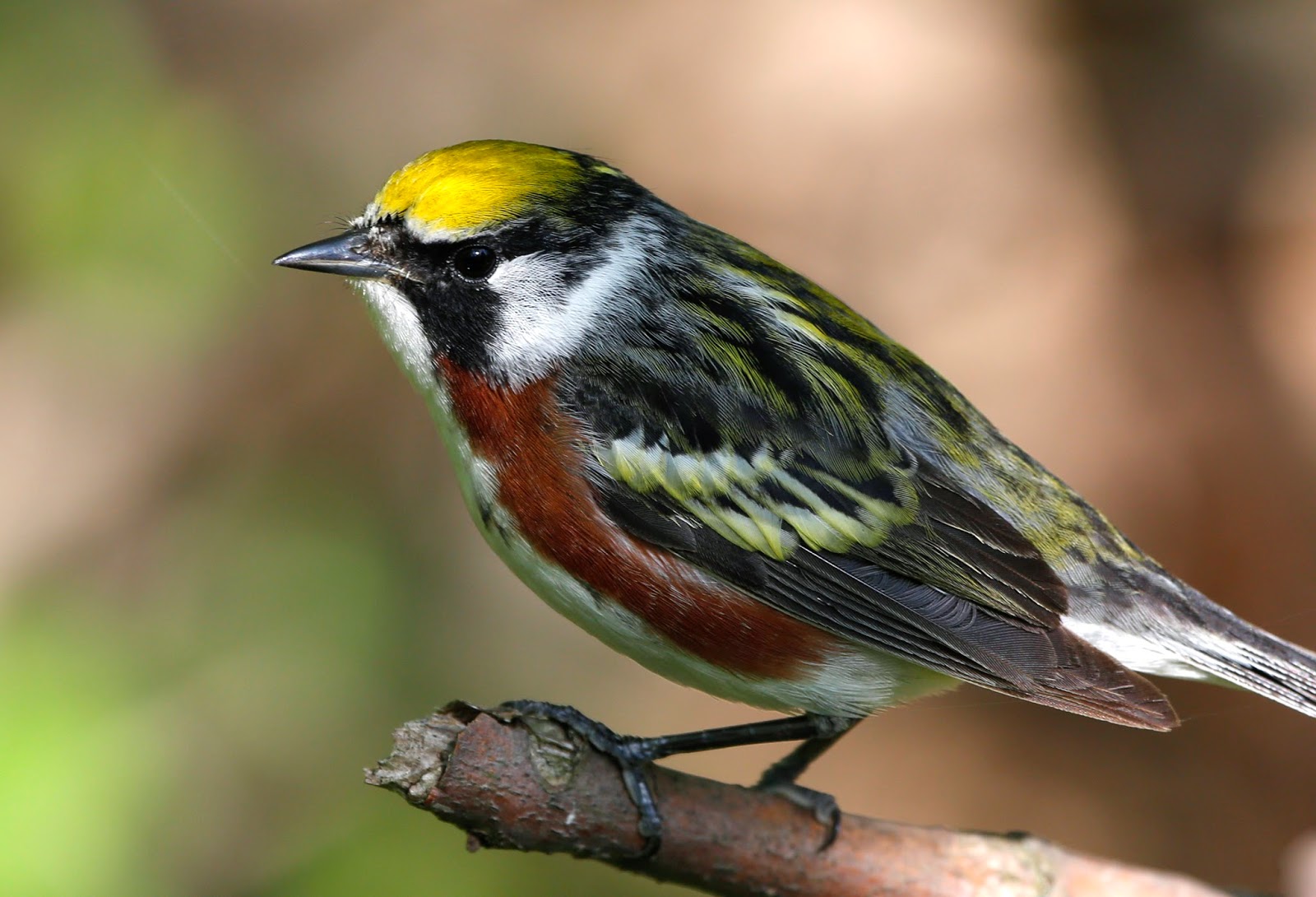I had breakfast as usual at 6 AM with Dan and Doreene, and Bert and Mike. We went our separate ways to bird. The winds were still favorable, so Dan, Doreene and I spent the day again birding Magee and Metzger marshes, and Ottawa NWR. Doreene noticed a new vanity plate which she coveted since the great gray owl is her favorite bird (my photo).
The warbler show continued being the main theme on the boardwalk with many black-throated blues and black-throated greens putting smiles on birders faces (all photos in today's post are Laura's unless indicated otherwise. Click on any photo to enlarge).
A new bird for the trip was a yellow-billed cuckoo that typically kept itself well hidden thus making it very difficult to obtain good photos. A distant olive-sided flycatcher kept the crowd busy for awhile in order to make a solid ID. I also saw my first blue-headed vireo and cedar waxwing of the trip. Overall the volume of birds was down a bit compared to the previous 4 days, but there was still good variety. By the end of the day my warbler species count was at 24, and I saw my first orange-crowned warbler of the trip.
One of the special opportunities provided only during the biggest week in birding is taking a bus ride into Cedar Point wildlife area which sits to the west of Ottawa NWR. Doreene had gotten reservations for the Tuesday morning tour that left at 7 AM. We had done this tour a couple of years ago, and wanted to try it again. As we were driving up to the entrance all 15 of us cheered the male turkeys competing with each other (my photo).
Once we were on the 1-way road that takes 3-4 hours to traverse with stops, we immediately began to see and hear birds. There were plenty of warblers but also birds not seen normally at Magee like tufted titmouse. We heard another least bittern calling in the reeds next to the road.
At our third stop along the way, I walked a bit ahead of the group which meant I missed seeing some white pelicans fly over because I did not hear anyone point them out. That was okay because as I was carefully scanning the bushes along the road I discovered a Kirtland's warbler--the rarest warbler in the ABA area. I quickly got Dan, Doreene and their friend Jeff to join me since they were closer than the rest of the group. We all quickly checked for the key field marks--overall large size, long tail that was flicked regularly while eating, broken eye-ring, large bill size, no yellow in the rump, gray back with some streaking, yellow throat and breast with some streaking, etc.--and concluded it was a female Kirtland's. And then the bird disappeared (photo above added on 5/22; taken by Keith Lott the next day on the bus tour).
We signaled the rest of the group to join us, and as they arrived, fortunately the Kirtland's popped up again. We were able to spend at least 10 minutes studying it as it fed which also meant lots of photos were obtained (photos above and below were taken by Jim Long). We were all pretty excited since the only other Kirtland's warbler seen so far in the area was yesterday at Kelly's Island on another bus tour. There were only about 400 Kirtland's left 40 years ago because of loss of habitat, and cowbird predation on the breeding grounds. Through the trapping of the cowbirds, and the expansion of the jack pine habitat in Michigan necessary for them to breed, today there are estimated to be 4000. As a result, since 2010 at least one Kirtland's has been found at or near Magee Marsh each year.
We finished our tour about 11:30, and headed back over to Magee in hopes of seeing a Henslow's sparrow that had been found earlier in the day. unlike the Kirtkand's warbler, Henslow's sparrows are not uncommon, but finding one on the boardwalk is totally surprising. It had been seen only briefly before it flew off, but by mid afternoon it was relocated feeding very close to the boardwalk. I have seen this species many times, but never at such a close range. It is one of our prettier sparrows.
As if a Henslow's and a Kirtland's was not enough, we finished our day at Pearson Park watching a full plumage female red-necked phalarope. Dan and Doreene said they thought this was only the 2nd red-necked phalarope that they had seen in the spring in over 20 years of birding in Ohio. My warbler count for the day was only 21 species, but the Kirtland's raised my warbler trip total to 31 in 6 days of birding which tied my personal best from last year. The day proved to be probably the best of the trip and a total of 99 bird species for the day, but the winds were beginning to shift to the north which was not a good sign.
Because the weather was not supposed to be so good on Wednesday, we got a bit later start than normal. We had not yet been over to Oak Openings, which is on the west side of Toledo. Dan, Doreene, their friend Bill, and I decided to spend the morning birding there. As we drove up we ran into a small group being led by Greg Miller. We immediately found grasshopper sparrow, and with a bit of work, blue-winged warbler which meant a new personal record for me of 32 for the trip. An hour later I was able to push the record up to 33 when we found a pair of pine warblers. About 11:30 the rain began to fall, so we drove back to have lunch in Oregon--a suburb of Toledo where we were staying.
With the rain subsiding, we headed back to Magee, stopping on the way to look at a large group of ruddy turnstones and black-bellied plovers most of which were in breeding plumage. Back at the boardwalk in only an hour's time we found lots of warblers including blackburnian and magnolia.
Next up was another run through Ottawa NWR on the auto tour. We were still looking for yellow-headed blackbirds, and black terns plus a reported king rail. We found none of them, but there was a pretty close pair of trumpeter swans (my photo), and a group of short-billed dowitchers in full breeding colors. We decided to head in for the day since the weather continued to be crummy. With the winds predicted to be coming out of the north for the next several days, I decided to start back home on tomorrow instead of staying until Sunday as I had planned.
I awoke to light rain that turned into heavier rain fairly quickly. Dan and Doreene decided to drive about 90 miles south to try to see a Wilson's phalarope as part of their 20th consecutive big year in Ohio.
I drove over to the boardwalk in hopes that the rain would let up, and maybe the bird I still most wanted to see--Connecticut warbler--would stop flying north because of the weather. I read for a bit until the rain stopped. I put on my rain gear and began to cruise the boardwalk. It was chilly, windy and there were almost no birders, but there were still birds to be seen including American redstarts and Tennessee warblers. Alas, no Connecticut warbler showed up.
I did see a Philadephia vireo, a few eastern wood pewees, and a young rose-breasted grosbeak (my photo). Dan and Doreene got back in time from their successful chase of the Wilson's phalarope for me to say good-bye to them as well as Jay, and to say hello to their friend Joe. I then made the 6 hour drive back to Beckley, W. VA. to be in position to bird some there on Friday.
I was on the road by 6 AM to make the short drive to Twin Falls SP--a place that I had read about, but never birded. It was cool and partly cloudy. I found a few birds--blue-headed and red-eyed vireos, white-breasted nuthatch, red-shouldered hawk, black-throated green warbler, and an ovenbird (my photo), but not my target bird--cerulean warbler. One had been reported when I was at Magee, but I heard about it too late to see it.
I decided to try another spot called Crump Bottoms that also was supposed to be good for ceruleans. It took me about 90 minutes to drive there. I arrived by 11 AM which gave me hope that the birds would still be singing. I made it down the somewhat rough gravel road including a stream crossing before finally reaching the bottom. I almost immediately heard a cerulean calling. With some patience and perseverance I finally saw it singing in a nearby tree. This is one of my favorite warblers and was a perfect last bird for the trip. It was the 34th warbler species of the trip, and having seen prairie and Swainson's warblers, and Louisiana waterthrush earlier this spring, it meant the only eastern warbler that I missed for the year was Connecticut which I consider the hardest warbler to find.
I needed to get on the road again in order to arrive in time to make dinner for my wife, so about 12:30 I began the 4 hour drive home. In reviewing my trip list, I ended up with 176 bird species seen over 8 full days of birding, and there were another 14 reported that I missed seeing. So I ended my now annual Magee Marsh trip with new personal bests for warbler species seen, and also total bird species seen. I would say that while no day at Magee this year was a "10" birdwise, it was the most consecutive days of high quality birding that I have experienced in my visits there. Also, as always I want to thank those birders who have shared their photos with me, especially Laura, so that this blog can be more colorful and entertaining. I will be heading out to Hatteras, NC next week to do a couple of pelagic trips with Brian Patteson. Stay tuned!
































































